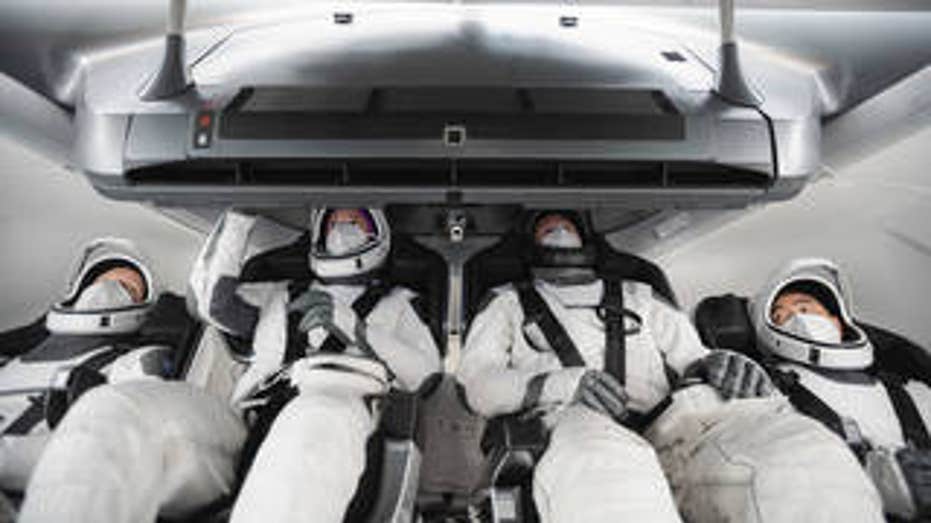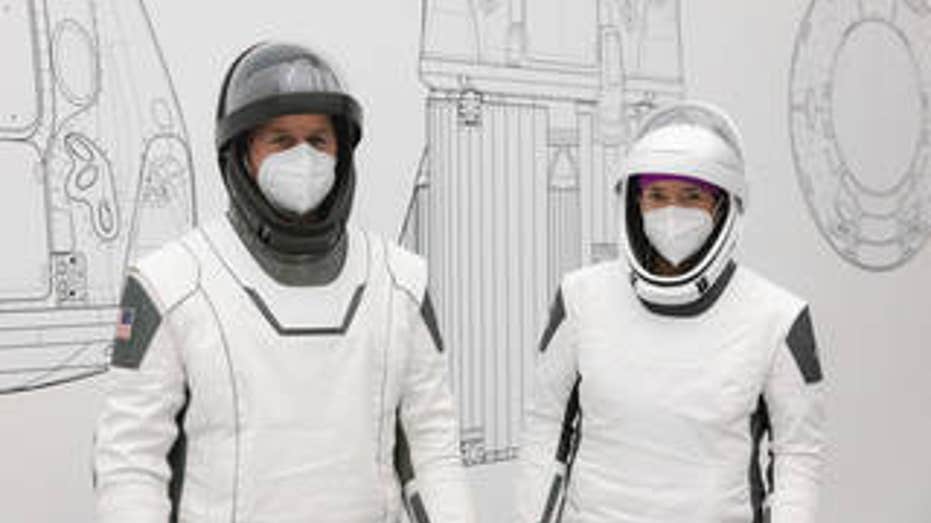NASA, SpaceX to launch second crew rotation mission to International Space
‘Bar Rescue’ host Jon Taffer discusses his role recruiting for SpaceX’s all-civilian crew.
NASA is preparing for its SpaceX Crew-2 mission, which will lift off from Launch Complex 39A at Kennedy Space Center in Florida no earlier than April 20.
SpaceX Crew-2’s four astronauts will fly aboard the aerospace company’s Crew Dragon capsule on top of a Falcon 9 rocket. The mission marks the first time in over 20 years that astronauts from NASA, the European Space Agency and Japan Aerospace Exploration Agency have flown together.

The crew for the second operational SpaceX Crew Dragon mission, SpaceX Crew-2, trains inside a mockup of the vehicle at the SpaceX training facility in Hawthorne, California. From left are, Mission Specialist Thomas Pesquet of the European Space Agen (SpaceX)
The astronauts of Crew 2 will be welcomed aboard the International Space Station by the Expedition 65 crew, including the Crew-1 astronauts who currently remain onboard. In total, the ISS will have a crew size of seven people.
ORBITAL ASSEMBLY CORP. HITS $1M FUNDRAISING GOAL, AIMS TO HAVE LUXURY SPACE HOTEL OPEN IN 2027
Crew Dragon will accelerate its passengers to approximately 17,500 mph and put it on an intercept course with the International Space Station. The Falcon 9 used to launch the mission is using the same booster as NASA’s SpaceX Crew-1, marking the first time a flight-proven booster will be used for a crewed launch.
Once in orbit, the crew and SpaceX mission control will monitor a series of automatic manuevers that will guide the crew to the International Space Station. Following a predetermined period in orbit, the Crew Dragon capsule will dock autonomously onto the station.
The Crew-2 astronauts will spend approximately six months aboard the station, conducting scientific research in areas such as medical technology, human health, and materials to benefit life on Earth, before returning in fall 2021.
During their stay on the orbiting laboratory, astronauts of Crew-2 will see cargo spacecraft, including the Northrop Grumman Cygnus and the SpaceX cargo Dragon and conduct a series of spacewalks to install new solar arrays, increasing the station’s total available power from 160 kilowatts to up to 215 kilowatts. The crew will also test the Butterfly IQ Ultrasound, a portable ultrasound device used in conjunction with a mobile computing device in the space environment.
In addition, they will conduct a variety of tissue engineering investigations, ranging from studies of bone, cardiovascular, muscle and liver health. An experiment from retail store Target will study cotton growth in microgravity to help identify more robust cotton varieties that require less water and pesticide use.
VIRGIN GALACTIC DELAYS SPACEFLIGHT TEST TO MAY
SpaceX Crew 2’s commander, Shane Kimbrough, will be responsible for all phases of flight, from launch to reentry. He also will serve as an Expedition 65 flight engineer aboard the station. Kimbrough, a retired U.S. Army colonel, first launched aboard space shuttle Endeavour for a visit to the station on the STS-126 mission in 2008, then aboard a Russian Soyuz spacecraft for Expedition 49/50 in 2016. He has spent a total of 189 days in space, and performed six spacewalks.
During a news conference on Monday, Kimbrough outlined the intense training that the crew has been going through in preparation for the mission over the past year.
“You’re doing a lot of academic classes, learning all their systems, and then you progress into the simulator where you’re just doing the kind of simulations with just you and your crewmates or maybe just in our case, Megan and I as pilot and commander. And then eventually you’ll get into the simulation campaign with the mission control teams from SpaceX and NASA. And that’s where we’re kind of in that phase right now, then kind of ramping that up with only a couple more weeks of that to go before we’re ready to fly in space.”

NASA astronauts (from left) Shane Kimbrough and Megan McArthur, commander and pilot respectively for the SpaceX Crew-2 mission to the International Space Station, pose for a portrait during a training session at the SpaceX training facility in Hawtho (SpaceX)
SpaceX Crew-2’s pilot, Megan McArthur, will be responsible for the spacecraft systems and performance. The mission will be McArthur’s first trip to the International Space Station. In 2009, McArthur launched on space shuttle Atlantis as a mission specialist on STS-125, the final Hubble Space Telescope servicing mission. She operated the shuttle’s robotic arm over the course of the 12 days, 21 hours she spent in space, capturing the telescope and moving crew members during the five spacewalks needed to repair and upgrade it.
McArthur said at Monday’s press conference that the most intense part of astronaut training has been “the volume and variety of the things that we have to cram into our brains before we get ready to launch.”
“We’re not only learning a brand…
Read More: NASA, SpaceX to launch second crew rotation mission to International Space

